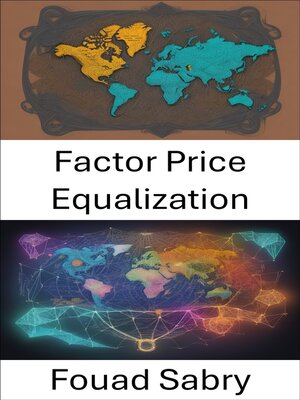Factor Price Equalization
ebook ∣ Unlocking the Global Trade Enigma, Mastering Factor Price Equalization · Economic Science
By Fouad Sabry

Sign up to save your library
With an OverDrive account, you can save your favorite libraries for at-a-glance information about availability. Find out more about OverDrive accounts.
Find this title in Libby, the library reading app by OverDrive.



Search for a digital library with this title
Title found at these libraries:
| Library Name | Distance |
|---|---|
| Loading... |
What is Factor Price Equalization
Factor price equalization is an economic theory, by Paul A. Samuelson (1948), which states that the prices of identical factors of production, such as the wage rate or the rent of capital, will be equalized across countries as a result of international trade in commodities. The theorem assumes that there are two goods and two factors of production, for example capital and labour. Other key assumptions of the theorem are that each country faces the same commodity prices, because of free trade in commodities, uses the same technology for production, and produces both goods. Crucially these assumptions result in factor prices being equalized across countries without the need for factor mobility, such as migration of labor or capital flows.
How you will benefit
(I) Insights, and validations about the following topics:
Chapter 1: Factor price equalization
Chapter 2: David Ricardo
Chapter 3: Comparative advantage
Chapter 4: Federal Reserve
Chapter 5: Transformation problem
Chapter 6: Cost-of-production theory of value
Chapter 7: Production-possibility frontier
Chapter 8: Stolper-Samuelson theorem
Chapter 9: Balassa-Samuelson effect
Chapter 10: Rybczynski theorem
Chapter 11: Heckscher-Ohlin model
Chapter 12: International economics
Chapter 13: Heckscher-Ohlin theorem
Chapter 14: Lange model
Chapter 15: International factor movements
Chapter 16: Luigi Pasinetti
Chapter 17: Factor market
Chapter 18: International trade theory
Chapter 19: Cambridge capital controversy
Chapter 20: Exploitation of labour
Chapter 21: Financial instrument
(II) Answering the public top questions about factor price equalization.
(III) Real world examples for the usage of factor price equalization in many fields.
Who this book is for
Professionals, undergraduate and graduate students, enthusiasts, hobbyists, and those who want to go beyond basic knowledge or information for any kind of Factor Price Equalization.






